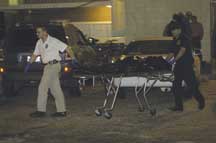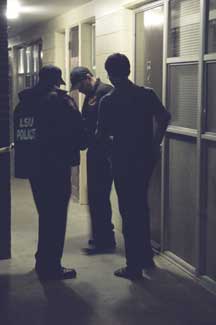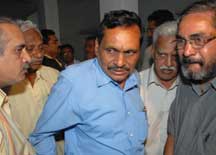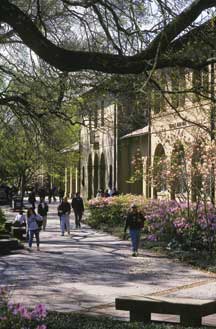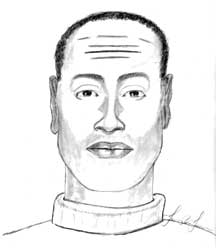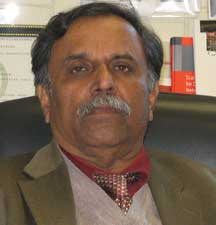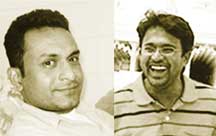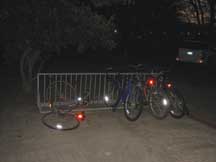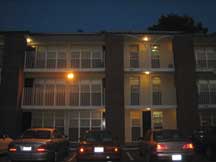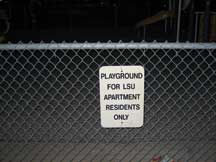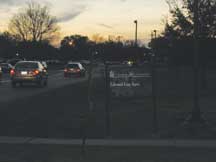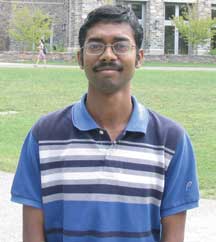Magazine
Murder and Mourning in Baton Rouge

Little India visits the Louisiana State University campus in Baton Rouge after the media lights have dimmed.
|
In the laundromat of Lousiana State University’s Edward Gay Apartments complex in Baton Rouge is a small stool on which sits a simple clay pot. The sole flower in the potted plant has already wilted. Tacked to the wall above it is a rudimentary paper sign pasted over aluminum foil, a valiant effort no doubt to create the effect of a plaque – of sorts. It reads simply, “In Memory of: Kiran and Komma.” The modest memorial is the sole visible reminder of a gruesome double homicide in the building that had attracted national media attention just one month earlier.
On Dec. 13, 2007, the last day of final exams, two suspects broke into the family housing complex, Edward Gay Apartments on campus and brutally murdered two doctoral students from Andhra Pradesh, Chandrasekhar Reddy Komma and Kiran Kumar Allam, sending shockwaves through a college unaccustomed to such violence and unleashing a flurry of national and international media attention. The Indian Student Association (ISA), a small social and cultural organization devoted to helping new Indian students adjust, was caught in the glare as reporters, television crews and community leaders turned to the group to which both victims belonged and began tapping them for information. “It was a madhouse,” Dheeraj Reddy, who serves as incoming student coordinator of the LSU-ISA admits. “We were right in the middle of exams when it happened.” He frowns. “I’d seen Kiran a few days ago and suddenly the phone’s ringing off the hook with strangers asking for a comment, personal stories about them.” He scratches the stubble covering his face. “It felt like an invasion and we weren’t ready for it. I don’t think anyone ever is.” Komma was strangled with a computer cable. Both men were shot in the head. But where the crime took place shocked nearly as much as its brutality. A college is thought to be a safe zone, a haven of sorts from the troubles beyond its boundaries. But LSU is surrounded by one of the worst neighborhoods in Baton Rouge, an area still rocked by the after effects of Hurricane Katrina, grappling with not only an influx of the homeless and unemployed, but the accompanying crime that follows disasters. Burglaries on campus quadrupled between 2004 and 2006.
On that December night, the outside world invaded the campus, shattering its illusions of safety. As Reddy’s roommate, Ravi Kavalipati, drives us around the college in his aging red hatchback, pointing out Komma and Allam’s favorite haunts, it’s hard not to notice the divisions left in the crime’s wake. School shootings are an unpleasant fact of life in this country. America is often at its graceful best, however, in its response to such tragedies. Pres. Geroge Bush and his wife Laura mourned with students at a convocation ceremony at Virginia Tech University the day after the massacre of 30 students in April there. The LSU killings occurred just as most students were preparing to head home for their winter break; the memorial services organized by the ISA were relatively low key. But in the glare of the media attention there were many promises: of providing support to the victims’ families; of apprehending the killers; of improving campus security. But as the campus stirred back to life at the start of the winter term in January after the public attention had dimmed, it is striking just how easily LSU has shrugged off the tragedy that seemed so riveting in its immediate aftermath. And perhaps nothing symbolized that calousness and indifference as much as that crude memorial tucked inside a laundromat. The investigation into the double homicide seems to have hit a dead end. And students remain wary about campus security. The university had announced a Komma and Allam Support Fund soon after the tragedy, but Little India could not prod any information from its public affairs office on just how much had been raised or disbursed from that fund. “You used to feel safe on campus,” says Dheeraj Reddy, a LSU student and incoming student coordinator of the ISA. We’re sitting on the steps of the Computer Science building, a popular hangout for Indians. “You can’t say that now.” The New Yorker in me was struck by the insularity pervasive among the different campus groups. The steps of the LSU Student Union, where Komma used to pull all-nighters, are teeming with West coast girls appraising outsiders with the cutting looks of the inner circle. The students smoking outside Tiger Stadium, where Allam, a huge basketball fan, would go to catch games, are divided by race and ethnicity. When I draw attention to this, Kavalipati is surprisingly matter-of-fact. “This is the South,” he says, as Reddy nods knowingly. “There’s always going to be that separation. It’s a fact of life. You can’t get hung up on it.”
Progress in desegregating the two major colleges in Baton Rouge, the predominantly white LSU and mainly black Southern University, has been slow. And while voters seem to have bridged the racial divide, electing an Indian American, Bobby Jindal, to the post of governor, the social segregation on the LSU campus seems a jarring throwback. “Because there are fewer Indians, finding each other means more,” Kavalipati says. “They’re the only ones who get what you’re going through, how scary it can be to come here alone.” Kavalipati moved here from India a year and a half ago with no family, only a rudimentary grasp of English, and little experience in navigating the currents of American society. It was either sink-or-swim, and he recalls his panic. That’s where the ISA came in. “The seniors helped me with everything from finding a place to stay to the best places for biryani. I’m from Hyderabad, so that was important,” he says with a smile. LSU is host to 332 Indian students, almost a quarter of all foreign students on campus and by far the largest number from any single country. Kavalipati speaks fondly of Komma’s kindness toward him during the first days. “He’d been here for nearly five years at that point, so he knew what I was going through,” he says. “He introduced me to his friends and offered to help in any way he could.” Komma was his inspiration when the time came to select new members of the organizing committee, to help out new incoming students. Kavalipati is the current president of the organization. As I enter the modest apartment he shares with Reddy, it’s hard not to remember my own college digs. Similarities abound: a messy jumble of second-hand furniture, stereo equipment and humming laptops. But what quickly becomes apparent in talking to them is the difference in their mentality as foreign students.
As a second-generation Indian, the dislocation of college life for me was always tempered by the certainty of better things to come. I knew this world and carried the sense of entitlement that comes with growing up in its embrace. And though my room was scarcely bigger than their cramped space and my bank account laughably bare, that confidence was the most valuable currency I possessed. It was an open ticket, allowing me to form friendships with Americans through pop culture references and a common background, enabling me to transcend racial barriers that might have otherwise hemmed me in. I began to believe, as many children of immigrants growing up in the West do, that this meant I was one of them. That when disaster struck, they’d treat me as one of their own. Like Kavalipati, neither Komma nor Allam had access to that ticket, so, at least in the beginning, it made them vulnerable. But, as I listen to the way they finish each other’s sentences and move through their daily routines with the ease of a married couple, I realize something else: When you do find someone like you, that bond becomes precious – a lifeline to the world outside.
By all accounts, Komma and Allam shared that bond. “They’d found that balance between the old life and this one,” says Reddy. “They loved living in the United States, but held onto Indian values. Kiran was a quiet guy, it might take you months to get to know him, but once you became his friend, you were in for life. Whatever you needed, any trouble you were in, you could call him up and he’d drop everything to be there. That’s rare.” K. Srinivas Reddy, Komma’s brother, in a telephone conversation from Kadpa district in Andhra Pradesh, recalls: “It wasn’t easy for him. But he never once complained. For him it was a life’s chance, for the whole family. Problems could never change that.” “As Indians you have to establish yourself as superior to the locals,” says Dr. S. Sitharama Iyengar, chairman of the Computer Sciences Department and faculty advisor to the ISA. “It’s the only way, and that means tremendous sacrifice. I don’t look at it as a double standard. It’s just the way the system works.” Iyengar, who is a nationally recognized scholar in his field, has been through the ringer himself. His goals today revolve not around the hard business of survival, but the management of the department, the Wireless Sensor Networks Laboratory and the Robotics Research Laboratory. And while he is all too eager to speak of his present research, the topic of the shootings hits a little too close to home. No immigrant ever leaves the struggling years completely behind, and what happened is a stark reminder that the price can sometimes be too high to bear. “It was a heinous act,” he says, still shaken. “For decent boys to meet a tragedy like this…it should never have occurred.”
Quickly distancing himself from its reminders, he points out how remote the apartments are from the main buildings and how inexpensive. It is the first hint of a pervasive trend on campus to push thoughts of these two men – these aberrations in the illusion of a wonderful campus life – out of mind. Buzz words abound: Inexpensive area. Unfortunate incident. Doing all that’s possible. The unstated: we’re doing what’s necessary, so stop looking. “They were living in the worst part of campus,” Kavalipati says plainly. “Should they be blamed for it? Back home, if you saw someone working at a restaurant, you’d lift your nose up, thinking it’s the best he could do. But it’s different here.” Outside the shadows are lengthening, and the lights of oncoming cars pulse against the windows. “Here you do whatever you have to, to get by. And you respect anyone else doing the same.” In the wake of the shootings, the national spotlight was turned on Baton Rouge as people struggled to understand the senseless, and point fingers. The school came under fire after an emergency text-messaging system failed, at least partially, to deliver news of the murders to subscribers. University officials blamed the service provider, clearTXT Inc., citing a “registration problem” that they say has since been resolved. “That was really a foolish thing,” admits Kavalipati. “The ISDS Department (Information Systems & Decision Sciences) was testing this service out, and the shooting was the first time they tried it.”
The failures underlined just how unprepared the university was to handle the tragedy, a failure that, in the post-Columbine and Virginia Tech age, some critics complain borders on negligence. Missed texts, however, are nothing compared to the flak the school received when the non-existent security measures at the Edward Gay Apartments were exposed. “Most places on campus require I.D. cards just to enter the premises,” says Kavalipati. “90 percent of the residents at Edward Gay have families with kids. Yet they had nothing.” At times, what’s lost in the shuffle to place blame are the victims themselves. Padma Allam, Kiran Allam’s aunt in Karimnagar district, Andhra Pradesh, remembers her nephew as a devoted family man. “I’d never seen someone more in love with [the idea of] being a father,” she says. “He’d come to visit me, and if there were children around, he was with them, playing. When he found out he was going to be a father…any hardship he had was fine. It was for the child now.” It’s dark by the time I leave Kavalipati and Reddy’s apartment. Perhaps a part of me was delaying on purpose, putting off the trip I knew I had to make to the site of the murders. What remained of the levity in the room has been sucked out in tandem with the fading sunlight.
What’s left is a claustrophobic waiting, a feeling of not knowing when the other shoe will drop. The fact that it’s happened, and could well recur, is the unspoken elephant in the room, yet neither Kavalipati nor Reddy are cowed by the fear. When I tell them where I’m going, Kavalipati offers to give me a ride. When I say that I’d like to make the walk that both Kiran and Komma had made countless times before, he nods. “Keep your head down,” he says. “And be careful.” It takes 20 minutes to walk from their apartment, located close to the university’s core, to Edward Gay, and the difference is shocking. You get what you pay for at LSU, and those unable to afford better get the dregs. A gravel road without streetlights leads to the two residential buildings. No gate. No visible cameras. No security. It is, for all intents and purposes, a housing project. As I reach the first set of apartments, I keep expecting to run into the new safety measures touted by the school. In an interview earlier, Detective David Heroman of the LSU Police Department, cited the presence of a community police officer at the apartments between 7 p.m. and 3 a.m. I visited well after 7 p.m. and saw no one except a resident fixing his car in the parking lot. Heroman also said the college was in the process of installing closed-circuit cameras, but even after I had spent nearly an hour roaming the area, going up to apartment doors and snapping pictures, no one questioned my presence. Except for a few seemingly new signs advertising the fact that regular LSU-PD patrols monitor the area, there is no indication that anything untoward had taken place there nor any suggestion of any security measures to prevent it from happening again. The place feels abandoned, but it isn’t. In the pitch-black of the parking lot, where the suspects supposedly sat in the cabin of an Oldsmobile Aero sizing up their potential victims, resident Omer Soysal was unloading groceries from the trunk of his car.
“Hold-ups and robberies happen here all the time,” he says. “International students can’t carry guns and the criminals know that.” Campus security is an issue all universities keep under tight wraps. Few students, least of all those moving from other countries, check publicly available campus crime statistics. In 2006, the most current data on file, LSU reported 53 burglaries in its residence halls, a fivefold increase since 2004. In 2006, there were two aggravated assaults and one arson in the residence halls. When I bring up the subject of Komma and Allam, Soysal’s frustration only intensifies. “I don’t think anyone here could have imagined people getting killed. But look around.” He gestures to the glowing strip of Highland Road, a main circuit cable feeding the worst of the city directly into campus. “We have nothing against that. Swapna [Kiran’s wife] was going to have a baby. Does this look like a good place to raise one? I’d tell anyone with a family to find another place to live.”
He pulls out the last of his bags and slams the trunk. “When you don’t have much you take what you can get. But we deserve better than this.” Detective Heroman declined comment on the lack of cameras and patrols at the apartments, one of only two on campus for graduate family housing. Like most officials involved in the case, he’s a master at staying on message: “There is a steady progress in the investigation that is being made at this time.” Despite a coordinated effort between the LSU Police, Baton Rouge Police Department, Louisiana State Police and East Baton Rouge Sheriff’s office, new leads seem to have dried up. On Jan 3, a local resident Dallas Joseph Staden was charged with criminal mischief after police determined that he had supplied them with false information, resulting in thousands of wasted man-hours on the case during a critical period immediately following the shootings. Spokesmen for the various task forces insist that the lapse of time is not all that crucial in a murder investigation. That what is now being rumored to be not two, but possibly four suspects comes with the territory. That a $5,000 reward for information leading to an arrest by Christmas Day, since downgraded to a paltry $1,000, is enough of an enticement for someone to come forward.* Baton Rouge is settling for different priorities. There are, for instance, the inauguration ceremonies for the would-be savior of Louisiana, Bobby Jindal, which cost, according to his press secretary Melissa Sellers, a few hundred thousand dollars. In the immediate aftermath of the attacks, repeated calls were placed to the governor-elect by members of the Indian community asking for a thorough probe. Jindal had campaigned vigorously on a platform to crack down on crime, so this incident seemed a perfect opportunity to test his resolve, as well as reassure his constituents, Indian and otherwise, of their safety. But Jindal said nothing and did nothing, instead stepping up fund-raising efforts for his inauguration celebrations. Finally, after nearly a week of silence, Jindal, whose transition offices are within sight of the Edward Gay Apartments, released a carefully worded statement through his press secretary expressing his condolences and confidence in local law enforcement in bringing the culprits to justice. Hes cautious, says Iyengar. And he has a big hat to wear. I think he believes that if he made too big of a fuss over this, people would think he only cares about Indians. I ask him if he shares that outlook. Just as a human being, he had a responsibility to spend some time here, to try and understand whats been going on. These are the people in his backyard. They deserve attention. Rajaiah Allam, Kirans father, is a man beyond recovery. During a telephone conversation from Karimnagar, he frequently drifts into random topics, as though unable to focus on the subject of his son directly. You live through your children, he says. Any happiness is theirs. And now hes gone. The day after the murders, the ISA held a small memorial service for Komma and Allam. Attended by over 300 people, it was the start of an ongoing commitment not just on the part of the organization, but the entire campus, to never forget them. Black ribbons, placed on the lapels of jackets and on Facebook profiles, have come to represent solidarity with the families. For a place where divisions run deep, the shootings have become a potent reminder of the larger community at LSU and the urgent need to forge ties to strengthen it.
“We’ve all been affected by this,” says student Shirindi Shetty. “It doesn’t matter whether they were Indians or not. We all lost two members of the school.” For those closest to the men on campus, the hardest part won’t be remembering, but rather, letting go of the “what ifs.” “My friend was going to meet them,” Kavalipati says. “But he was 10 minutes late. By the time he got there…it was already over. And now all he can think about is how, if he had only been on time, they might still be alive.” He shakes his head. “It’s no good to think like that, but what else can you do?” As I walk through the playground for the children living in the Edward Gay Apartments and sift through a pile of cast-off furnishings stacked against a corner of the building, I realize how tempting it would be to imagine a different outcome… and how futile. For even if Kavalipati’s friend had made it, getting them out in time, the suspects would have still been out in the pitch-black of the parking lot, deciding on their next victim. It wouldn’t have mattered whether they were Indian or not, whether their second-generation background gave them the pleasant illusion of greater safety, whether they believed in the American Dream or were simply trying to get by. Someone was going to die. Despite protestations to the contrary, the LSU administration found it acceptable to shuffle foreigners into substandard and unsafe housing, banking on the conviction that they’d not protest. According to LSU housing data, 94% of the residents at the Edward Gay Apartments were foreign students. A month after the murders, almost nothing had been done to make the apartment complex any more secure. “Things have got to change,” says Soysal. “Because it’s just going to get worse.”
The crime scene ticker tape over the first-floor entrance to Allam’s apartment has been long removed. All evidence of the violence has been swept away. The only sign that two men had a life here, had hopes and dreams for their families, lies in the makeshift memorial in the laundromat. As hard as I might try to imagine that the fact that Komma and Allam were brown foreigners has nothing to do with the indifference I sensed in Baton Rouge, I can’t. As much as I might try to understand the political imperitive that caused Jindal to ignore their plight, I can’t. I suspect that the potted plant in the makeshift memorial too has withered completely by now. *On Jan 30, the LSU Task Force informed Little India that the reward money for information on the muder had been increased back to $5,000, thanks to an anonymous donor. Edward Gay Apartment Complex on a Recent Mid-January Night You get what you pay for at LSU, and those unable to afford better get the dregs. A gravel road without streetlights leads to the two residential buildings. No gate. No visible cameras. No security. It is, for all intents and purposes, a housing project. As I reach the first set of apartments, I keep expecting to run into the new safety measures touted by the school.
|

